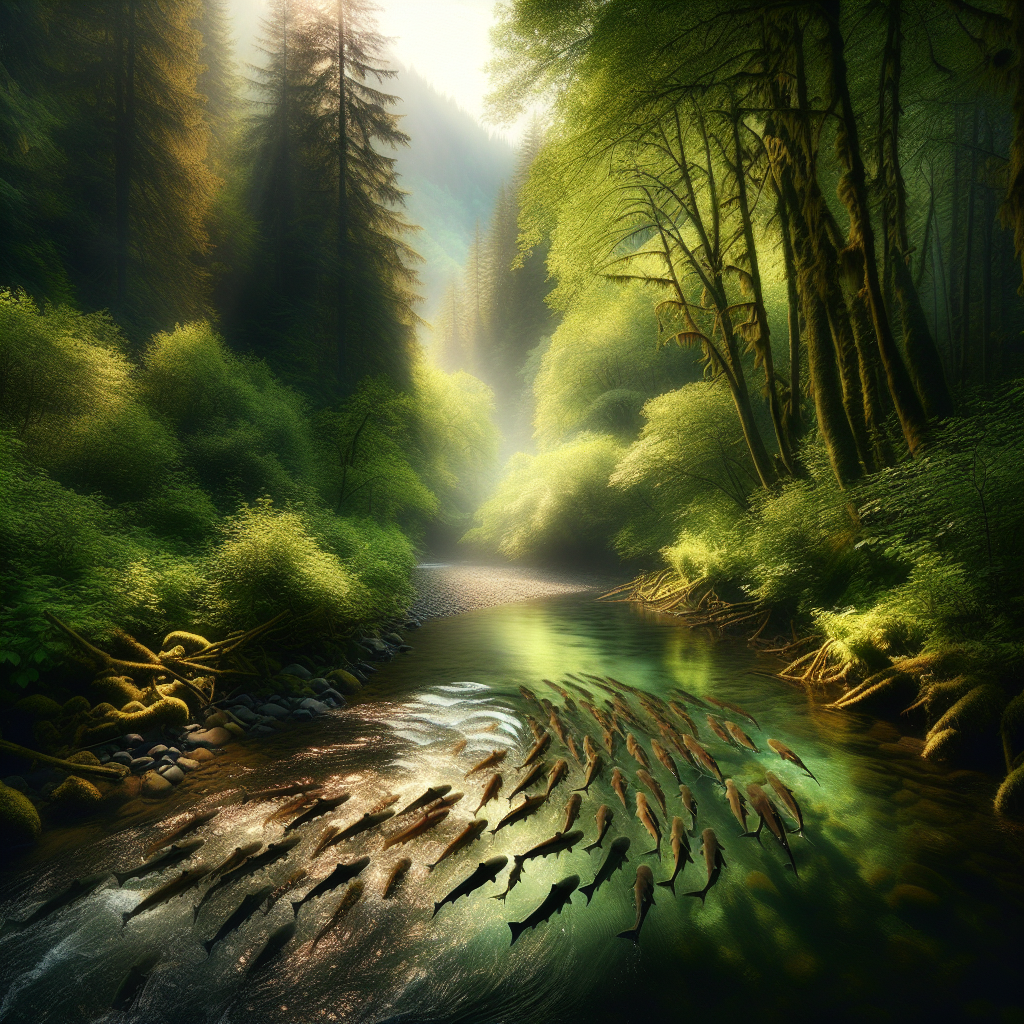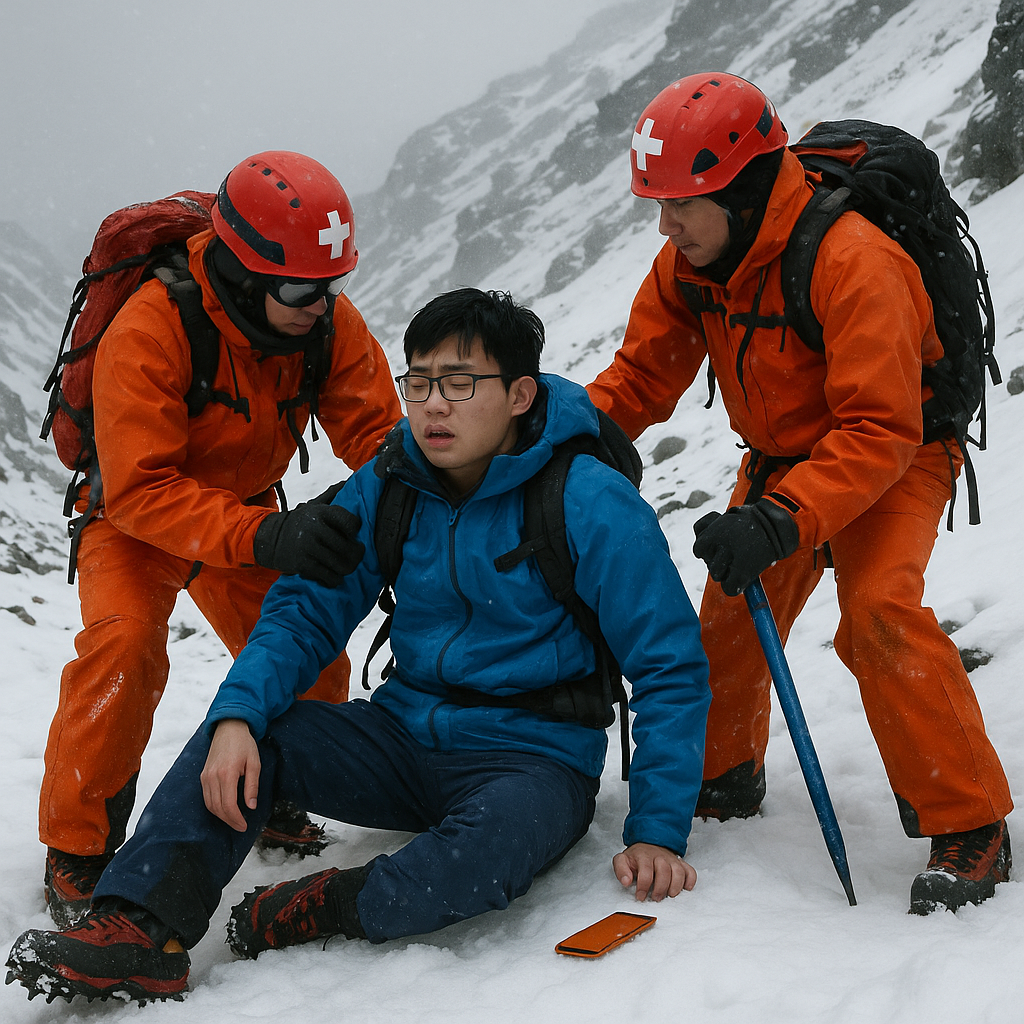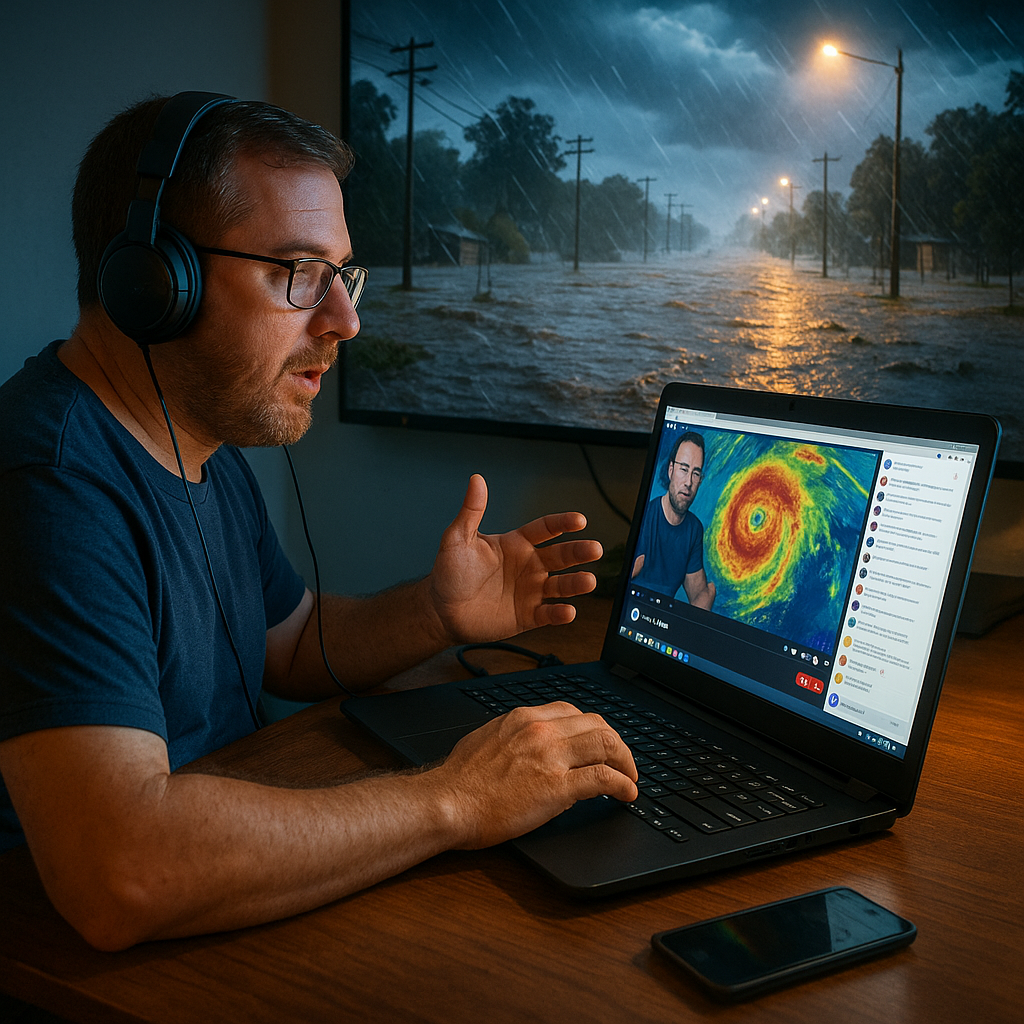Last week, a truck carrying 102,000 live salmon crashed in Oregon. This accident caused thousands of young fish to end up in the wrong river. The salmon were supposed to go to the Imnaha River, where they are considered threatened. However, around 77,000 of them ended up in the Lookingglass Creek instead. Thankfully, the driver of the truck only suffered minor injuries.
The crash happened because the driver lost control on a sharp turn, causing the truck to roll down a rocky slope. Sadly, more than 25,000 of the salmon, which were about two years old, died either inside the truck or on the creek bank. The local sheriff’s office and two Native American tribes helped collect and scan transponders on the dead fish.
Salmon are special because they spend most of their lives in the ocean but return to rivers to lay their eggs. Many are raised in hatcheries before being released into their home waters. The Oregon Department of Fish and Wildlife (ODFW) estimates that the loss of these fish is about 20% of what was supposed to be released into the Imnaha River this year. They predict that there will be 500-900 fewer adult fish returning to spawn in 2026-2027 because of this accident. However, the 77,000 young salmon in the Lookingglass Creek will likely result in an extra 350-700 adults returning there.
ODFW officials are grateful that the truck driver wasn’t seriously hurt. They also believe that this incident won’t affect their ability to collect future fish or meet their goals in the future.
Original news source: Truck crash spills live salmon into Oregon river (BBC)
🎧 Listen:
Slow
Normal
Fast
📖 Vocabulary:
| 1 | salmon | A type of fish that is known for its long journeys from the ocean back to rivers |
| 2 | threatened | At risk of becoming extinct or disappearing |
| 3 | hatcheries | Places where young fish are bred and raised before being put into natural waters |
| 4 | spawn | The act of fish laying eggs |
| 5 | transponders | Small devices used to track the location or movement of something |
| 6 | incident | An event, especially one that is bad or unusual |
| 7 | estimates | Careful guesses about the size, number, or amount of something |
| 8 | grateful | Feeling thankful for something |
| 9 | slope | The side of a hill or mountain that has a gradual or steep incline |
| 10 | scan | To look closely at something to gather information |
| 11 | creek | A small stream or river |
| 12 | endangered | In danger of no longer existing |
| 13 | collect | To gather things together from different places |
| 14 | released | To allow something to go free into its natural environment |
| 15 | goals | The aims or objectives that someone wants to achieve |
Group or Classroom Activities
Warm-up Activities:
– News Summary
Instructions:
1. Divide the class into pairs or small groups.
2. Give each group a copy of the article.
3. Have the groups read the article together.
4. Instruct the groups to write a summary of the article, focusing on the main points and key details.
5. After a designated amount of time, have each group share their summary with the class.
6. Facilitate a discussion about the article, allowing students to ask questions and share their thoughts.
– Vocabulary Pictionary
Instructions:
1. Write a list of key vocabulary words from the article on the board.
2. Divide the class into pairs or small groups.
3. Instruct each group to choose one word from the list.
4. Give the groups a few minutes to discuss and plan how they will represent the word through a drawing.
5. Have each group take turns drawing their word on the board while the rest of the class tries to guess what it is.
6. After each word is guessed, discuss the meaning and context of the word as a class.
– Pros and Cons
Instructions:
1. Divide the class into pairs or small groups.
2. Assign each group the task of discussing the pros and cons of the situation described in the article (the salmon truck accident).
3. Instruct the groups to make a list of at least three pros and three cons.
4. After a designated amount of time, have each group share their lists with the class.
5. Facilitate a class discussion, allowing students to share their opinions and thoughts on the topic.
– Think-Pair-Share
Instructions:
1. Read aloud the following prompt: “What are some potential consequences of the salmon truck accident? Discuss with a partner and be prepared to share your ideas with the class.”
2. Give students a few minutes to think about and jot down their ideas individually.
3. Pair students up and have them discuss their ideas with their partner.
4. After a designated amount of time, have pairs share their ideas with the class.
5. Facilitate a class discussion, encouraging students to build on each other’s ideas and share different perspectives.
– Opinion Spectrum
Instructions:
1. Draw a horizontal line on the board.
2. Label one end of the line “Strongly Agree” and the other end “Strongly Disagree.”
3. Read aloud a statement related to the article (e.g. “The truck driver should be held responsible for the accident”).
4. Instruct students to stand along the line according to their level of agreement with the statement, with “Strongly Agree” on one end and “Strongly Disagree” on the other.
5. After everyone has chosen their position, allow students to explain their reasoning and engage in respectful debate with their classmates.
6. Facilitate a class discussion, encouraging students to consider different perspectives and find common ground.
🤔 Comprehension Questions:
1. What happened to the truck carrying the live salmon in Oregon?
2. Where were the salmon supposed to go, and where did they end up instead?
3. How many of the salmon died in the accident?
4. How did the local sheriff’s office and Native American tribes help after the accident?
5. Why are salmon considered special?
6. Where are many salmon raised before being released into rivers?
7. How much of the fish that were supposed to be released into the Imnaha River were lost in the accident?
8. What do ODFW officials believe about the incident’s impact on their future goals?
Go to answers ⇩
🎧✍️ Listen and Fill in the Gaps:
Last week, a truck carrying 102,000 live (1)______ crashed in Oregon. This (2)______ caused thousands of young fish to end up in the wrong (3)______. The salmon were supposed to go to the Imnaha River, where they are considered threatened. However, around 77,000 of them ended up in the Lookingglass Creek instead. Thankfully, the (4)______ of the truck only suffered minor injuries.
The crash happened because the driver lost control on a sharp turn, causing the (5)______ to roll down a rocky (6)______. Sadly, more than 25,000 of the salmon, which were about two years old, died either inside the truck or on the creek bank. The local sheriff’s office and two (7)______ American tribes helped collect and scan transponders on the dead fish.
Salmon are (8)______ because they spend most of their lives in the ocean but return to rivers to lay their eggs. Many are raised in hatcheries before being released into their home waters. The Oregon Department of Fish and (9)______ (ODFW) estimates that the loss of these fish is about 20% of what was (10)______ to be released into the Imnaha River this year. They (11)______ that there will be 500-900 (12)______ adult fish returning to spawn in 2026-2027 because of this accident. However, the 77,000 young salmon in the Lookingglass Creek will likely result in an (13)______ 350-700 (14)______ returning there.
ODFW officials are (15)______ that the truck driver wasn’t seriously hurt. They also believe that this incident won’t affect their (16)______ to collect future fish or meet their goals in the future.
Go to answers ⇩
💬 Discussion Questions:
Students can ask a partner these questions, or discuss them as a group.
1. What is a hatchery and why are salmon raised in hatcheries?
2. How would you feel if you were the truck driver in this accident?
3. Do you think the accident will have a big impact on the salmon population in the Imnaha River? Why or why not?
4. What do you think the Native American tribes did to help collect and scan the dead fish?
5. How do you think the salmon ended up in the wrong river?
6. Do you like eating salmon? Why or why not?
7. What do you think the Oregon Department of Fish and Wildlife can do to prevent accidents like this in the future?
8. How would you feel if you were one of the salmon that ended up in the wrong river?
9. What do you think the transponders on the dead fish were used for?
10. Do you think the accident will affect the ecosystem of the Lookingglass Creek? Why or why not?
11. How do you think the accident could have been prevented?
12. What do you think the truck driver could have done differently to avoid the accident?
13. How would you feel if you were a fisherman who relies on the salmon population for your livelihood?
14. Do you think the truck driver should be held responsible for the accident? Why or why not?
15. What do you think the Oregon Department of Fish and Wildlife’s goals are for the future?
Individual Activities
📖💭 Vocabulary Meanings:
Match each word to its meaning.
Words:
1. salmon
2. threatened
3. hatcheries
4. spawn
5. transponders
6. incident
7. estimates
8. grateful
9. slope
10. scan
11. creek
12. endangered
13. collect
14. released
15. goals
Meanings:
(A) A type of fish that is known for its long journeys from the ocean back to rivers
(B) In danger of no longer existing
(C) An event, especially one that is bad or unusual
(D) Careful guesses about the size, number, or amount of something
(E) The side of a hill or mountain that has a gradual or steep incline
(F) To gather things together from different places
(G) At risk of becoming extinct or disappearing
(H) To allow something to go free into its natural environment
(I) The act of fish laying eggs
(J) Feeling thankful for something
(K) To look closely at something to gather information
(L) The aims or objectives that someone wants to achieve
(M) A small stream or river
(N) Places where young fish are bred and raised before being put into natural waters
(O) Small devices used to track the location or movement of something
Go to answers ⇩
🔡 Multiple Choice Questions:
1. What happened to the truck carrying live salmon in Oregon?
(a) It caught fire
(b) It was stolen
(c) It crashed
(d) It broke down
2. Where were the salmon supposed to go?
(a) Lookingglass Creek
(b) Columbia River
(c) Snake River
(d) Imnaha River
3. How many of the salmon ended up in the wrong river?
(a) Around 102,000
(b) Around 25,000
(c) Around 77,000
(d) Around 500-900
4. What caused the truck to crash?
(a) The brakes failed
(b) The driver lost control on a sharp turn
(c) The road was slippery
(d) Another vehicle crashed into it
5. How many of the salmon died in the accident?
(a) More than 25,000
(b) Less than 25,000
(c) More than 102,000
(d) Less than 77,000
6. What did the local sheriff’s office and Native American tribes do to help?
(a) They collected and scanned transponders on the dead fish
(b) They rescued the surviving salmon
(c) They repaired the truck
(d) They cleaned up the accident site
7. Why are salmon considered special?
(a) They can fly
(b) They spend most of their lives in the ocean but return to rivers to lay their eggs
(c) They are the largest fish in the world
(d) They are the fastest swimmers in the ocean
8. How will this accident affect the number of adult fish returning to spawn in the future?
(a) There will be 350-700 extra adult fish returning to spawn in 2026-2027
(b) There will be no impact on the number of adult fish returning to spawn
(c) There will be a significant increase in the number of adult fish returning to spawn
(d) There will be 500-900 fewer adult fish returning to spawn in 2026-2027
Go to answers ⇩
🕵️ True or False Questions:
1. The driver of the truck only suffered minor injuries.
2. A truck carrying under 100,000 live salmon crashed in Oregon last week.
3. The Oregon Department of Fish and Wildlife believes that this incident won’t affect their ability to collect future fish or meet their goals in the future.
4. Less than 25,000 of the salmon survived either inside the truck or on the creek bank.
5. The accident caused hundreds of young fish to end up in the wrong river.
6. The local sheriff’s office and two Native American tribes helped collect and scan transponders on the dead fish.
7. The loss of these fish is about 20% of what was supposed to be released into the Imnaha River this year.
8. The salmon were supposed to go to the Imnaha River, but ended up in the Lookingglass Lake instead.
Go to answers ⇩
📝 Write a Summary:
Write a summary of this news article in two sentences.
Check your writing now with the best free AI for English writing!
Writing Questions:
Answer the following questions. Write as much as you can for each answer.
Check your answers with our free English writing assistant!
1. What happened to the truck carrying the live salmon in Oregon?
2. Where were the salmon supposed to go, and where did they end up instead?
3. How did the accident happen?
4. How many of the salmon died in the accident?
5. How will this accident affect the number of adult fish returning to spawn in the future?
✅ Answers
🤔✅ Comprehension Question Answers:
1. What happened to the truck carrying the live salmon in Oregon?
The truck carrying the live salmon crashed in Oregon.
2. Where were the salmon supposed to go, and where did they end up instead?
The salmon were supposed to go to the Imnaha River, but they ended up in the Lookingglass Creek instead.
3. How many of the salmon died in the accident?
More than 25,000 of the salmon died in the accident.
4. How did the local sheriff’s office and Native American tribes help after the accident?
The local sheriff’s office and Native American tribes helped collect and scan transponders on the dead fish.
5. Why are salmon considered special?
Salmon are considered special because they spend most of their lives in the ocean but return to rivers to lay their eggs.
6. Where are many salmon raised before being released into rivers?
Many salmon are raised in hatcheries before being released into rivers.
7. How much of the fish that were supposed to be released into the Imnaha River were lost in the accident?
The loss of fish in the accident is about 20% of what was supposed to be released into the Imnaha River.
8. What do ODFW officials believe about the incident’s impact on their future goals?
ODFW officials believe that this incident won’t affect their ability to collect future fish or meet their goals in the future.
Go back to questions ⇧
🎧✍️✅ Listen and Fill in the Gaps Answers:
(1) salmon
(2) accident
(3) river
(4) driver
(5) truck
(6) slope
(7) Native
(8) special
(9) Wildlife
(10) supposed
(11) predict
(12) fewer
(13) extra
(14) adults
(15) grateful
(16) ability
Go back to questions ⇧
📖💭✅ Vocabulary Meanings Answers:
1. salmon
Answer: (A) A type of fish that is known for its long journeys from the ocean back to rivers
2. threatened
Answer: (G) At risk of becoming extinct or disappearing
3. hatcheries
Answer: (N) Places where young fish are bred and raised before being put into natural waters
4. spawn
Answer: (I) The act of fish laying eggs
5. transponders
Answer: (O) Small devices used to track the location or movement of something
6. incident
Answer: (C) An event, especially one that is bad or unusual
7. estimates
Answer: (D) Careful guesses about the size, number, or amount of something
8. grateful
Answer: (J) Feeling thankful for something
9. slope
Answer: (E) The side of a hill or mountain that has a gradual or steep incline
10. scan
Answer: (K) To look closely at something to gather information
11. creek
Answer: (M) A small stream or river
12. endangered
Answer: (B) In danger of no longer existing
13. collect
Answer: (F) To gather things together from different places
14. released
Answer: (H) To allow something to go free into its natural environment
15. goals
Answer: (L) The aims or objectives that someone wants to achieve
Go back to questions ⇧
🔡✅ Multiple Choice Answers:
1. What happened to the truck carrying live salmon in Oregon?
Answer: (c) It crashed
2. Where were the salmon supposed to go?
Answer: (d) Imnaha River
3. How many of the salmon ended up in the wrong river?
Answer: (c) Around 77,000
4. What caused the truck to crash?
Answer: (b) The driver lost control on a sharp turn
5. How many of the salmon died in the accident?
Answer: (a) More than 25,000
6. What did the local sheriff’s office and Native American tribes do to help?
Answer: (a) They collected and scanned transponders on the dead fish
7. Why are salmon considered special?
Answer: (b) They spend most of their lives in the ocean but return to rivers to lay their eggs
8. How will this accident affect the number of adult fish returning to spawn in the future?
Answer: (d) There will be 500-900 fewer adult fish returning to spawn in 2026-2027
Go back to questions ⇧
🕵️✅ True or False Answers:
1. The driver of the truck only suffered minor injuries. (Answer: True)
2. A truck carrying under 100,000 live salmon crashed in Oregon last week. (Answer: False)
3. The Oregon Department of Fish and Wildlife believes that this incident won’t affect their ability to collect future fish or meet their goals in the future. (Answer: True)
4. Less than 25,000 of the salmon survived either inside the truck or on the creek bank. (Answer: False)
5. The accident caused hundreds of young fish to end up in the wrong river. (Answer: False)
6. The local sheriff’s office and two Native American tribes helped collect and scan transponders on the dead fish. (Answer: True)
7. The loss of these fish is about 20% of what was supposed to be released into the Imnaha River this year. (Answer: True)
8. The salmon were supposed to go to the Imnaha River, but ended up in the Lookingglass Lake instead. (Answer: False)
Go back to questions ⇧













